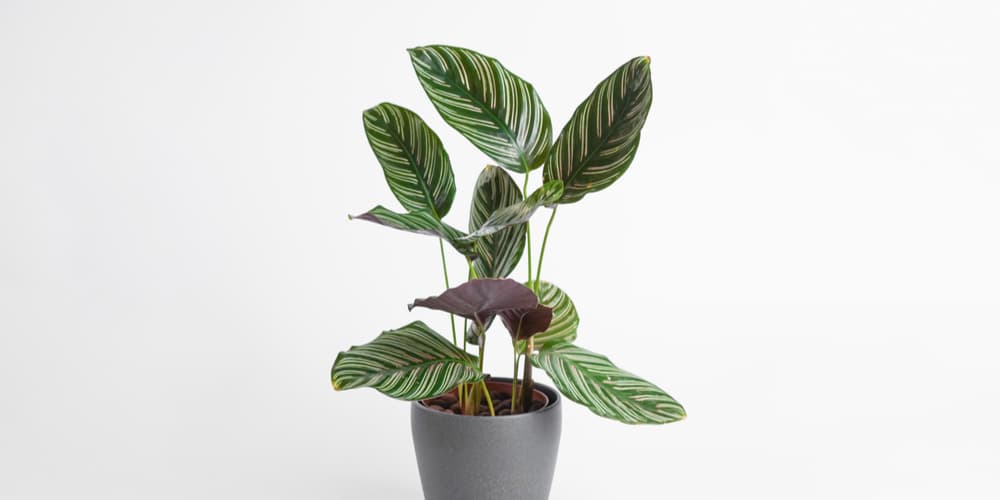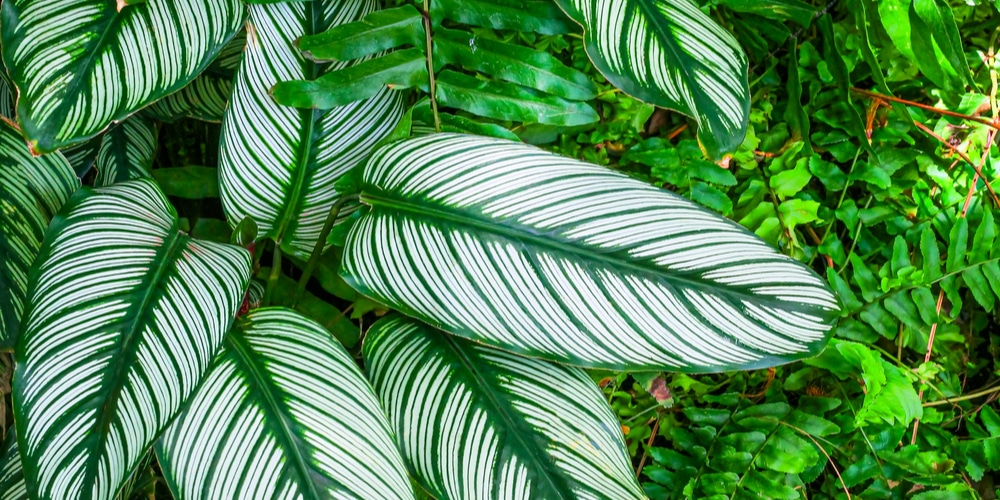Calathea Ornata (also known as pin strip plant) is a popular houseplant that can add a splash of green to any home and give a dramatic touch that will make a considerable difference in the look of your interiors. With their astonishing lush dark green leaves, they can brighten up your house. Plus, this variation features delicate pink stripes that make it even more attractive. The contrast between the dark green of the foliage and the pink strips becomes even more evident as the leaves rise in response to the sun: the result is stunning!
Despite (or because of) its beauty, Calathea Ornata is a plant that requires some attention. For this reason, it falls in the category of high-maintenance plants. But don’t let this discourage you from getting one! Indeed, while it can be a bit of a hassle to take care of, you only need the right tips and advice to keep a healthy Calthea in your house.
If you have just bought a pinstripe plant or would like to get one, you must learn to care for it. The good news is that you’ve landed in the right place: in this essential guide, you’ll find everything you need to know about this stunning houseplant.
How to care for the Calathea Ornata plant
Calathea Ornata is a perennial plant native to South American tropical forests. Given its natural habitat, this plant thrives in warmth and moisture. Overall, it does much better indoors. However, if the conditions outside are appropriate, you can also grow it in your garden. If you choose to do so, consider placing it in a pot so that you can move it indoors when necessary. Keep in mind that the container must be big enough to allow this tropical plant to grow.
To make sure your Calathea grows well, pay attention to the following sections. If you are a beginner, you’ll have to be particularly careful with this plant: it is not uncommon to hear stories of people struggling with this type of plant. However, it is possible to maintain healthy Calatheas! Read the following sections to find out how.
Sunlight
Like any other tropical plant, Calathea Ornata requires bright indirect light. Choosing the appropriate spot is not as trivial as it may sound. If this plant doesn’t receive enough light, it will not grow. However, with too much of it, it will quickly burn. The ideal location is near a bright window with sheer curtains, better if facing east.
To protect your plant from receiving too much sun, pay close attention to its leaves, which are finer than the Calathea Exotica. If you notice the stripes vanishing, the light is too bright: it is a sign that you’ll have to move your plant.
Watering
Calathea needs plenty of water and a moist environment. As a rule of thumb, the soil must never be dry. However, it shouldn’t be completely saturated. Make sure you choose an appropriate potting mix to avoid causing the roots to rot. In general, you should water your Calathea Ornata at least every two to three days. Feel the humidity with your fingers to ensure you are doing it right. If the soil is dry one or two inches below its surface, it is time to give it more water.
When it comes to water, this plant can be a bit fussy. Avoid using water that is heavy on minerals. If your tap water has this characteristic, you should consider filtering the water or using rainwater. Indeed, a Calathea with too many minerals might develop spots on its leaves. Remember to clean the plant’s leaves with a damp cloth to keep them shiny.
Pruning
To make your plant focus its energy on growing healthy leaves, you will have to prune your Calathea regularly. Also, if you notice unhealthy leaves, you must remove them to avoid damaging your plant. However, if the problem is small, you can trim the crispy tips without getting rid of the whole leaf.
Humidity
Tropical plants require humid environments. That’s why the bathroom or the kitchen are good spots to place it in, provided that they receive enough sunlight. You can add humidity by regularly misting the leaves using a spray bottle with water. Additionally, you may want to think about making a humidity tray with a layer of pebbles. If you place the plant on top of it and add water to the stones, it will maintain moisture without rotting. Still, if you are unsure about handling humidity, you can add an air humidifier near the plant’s pot.
USDA Climate Zones for Outdoor Growth
Temperature is just as important as other factors for keeping a healthy Calathea Ornata. If you place it indoors, make sure the temperature in your house is adequate for the survival of this plant. Temperatures that go lower than 60 are not good options for a Calathea. Additionally, this houseplant is susceptible to problems caused by sudden changes in temperature. Keep an eye on your plant and move it to a new location if you notice some changes.
To grow this plant outdoors, you must live in warm regions with mild winters and without too sudden temperature changes. USDA zones 11 and 12 provide the optimal conditions for the growth of your Calathea. These regions feature temperatures that do not go below 50 and are relatively stable all year long.
Fertilizer
Adding fertilizer will make your plant look even more gorgeous. Consider getting a high-quality general fertilizer for houseplants and add it once a month during the spring and summer. Alternatively, you can use organic compost: you will get the same results.
Don’t forget that overfertilizing a plant will not lead to increased growth. Instead, it might burn it or make it tall without being lush and voluminous.
Soil Type
Because of its watering requirements, Calathea Ornata needs soil that retains moisture without being soggy. You can use a rich organic pot mix and add some perlite or an African violet mix to keep it simple. Avoid heavy compact soils as they retain too much moisture and will cause rotting or attract diseases. The pH requirements are not strict, but slightly acidic soils give better results.
Calathea Ornata Propagation
Propagating a Calateha is slightly different than with other plants. Indeed, stem cutting doesn’t work for this plant. Instead, you’ll need to divide the plant at the roots during the growing season and repot the parts you take. Remember not to overwater the smaller plants and to give them appropriate care. After repotting, the plant might require some time to adjust, so don’t worry if you don’t see it growing immediately.
Calathea Ornata Care: Final thoughts
As you might have noticed, the requirements for growing a Calathea are a bit demanding. However, if you commit to following the tips and guidelines we included here, you will have no issue maintaining a lush and healthy Calathea at home.


